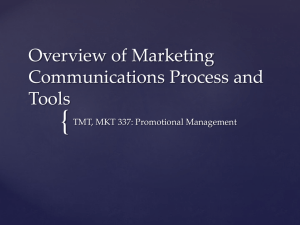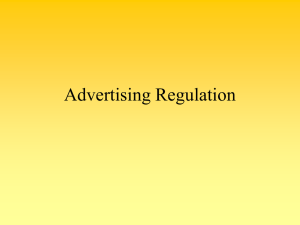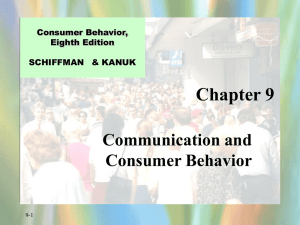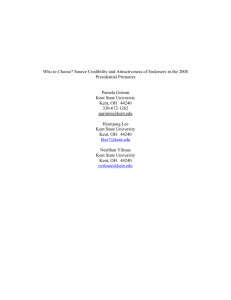Extended Abstract - Association for Consumer Research
advertisement
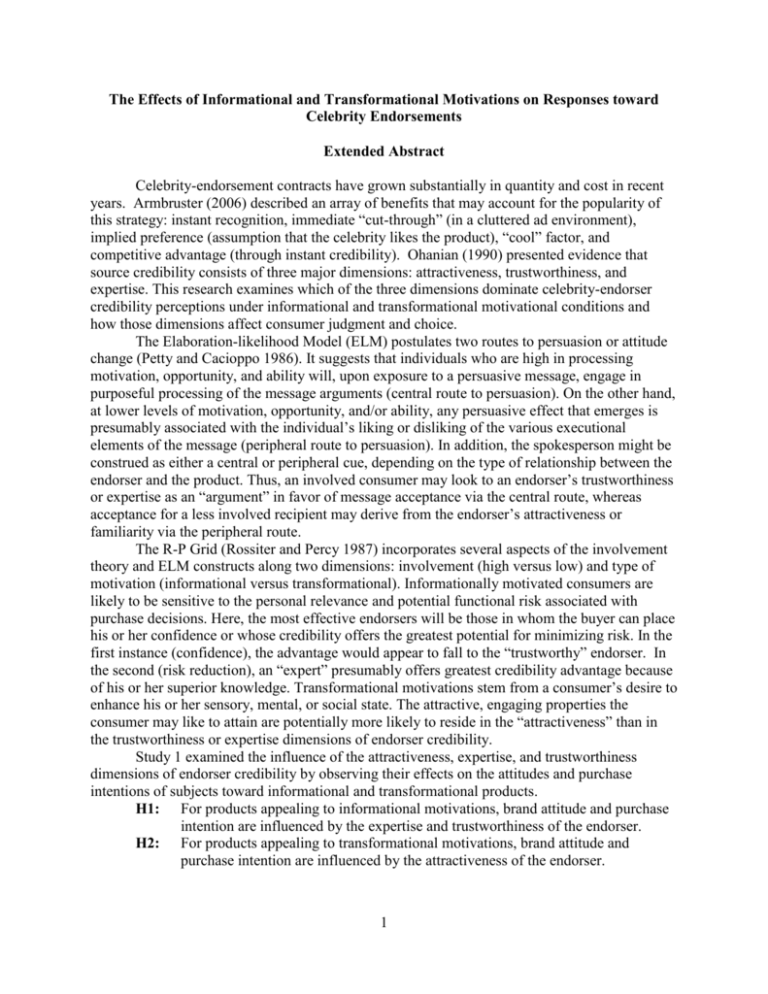
The Effects of Informational and Transformational Motivations on Responses toward Celebrity Endorsements Extended Abstract Celebrity-endorsement contracts have grown substantially in quantity and cost in recent years. Armbruster (2006) described an array of benefits that may account for the popularity of this strategy: instant recognition, immediate “cut-through” (in a cluttered ad environment), implied preference (assumption that the celebrity likes the product), “cool” factor, and competitive advantage (through instant credibility). Ohanian (1990) presented evidence that source credibility consists of three major dimensions: attractiveness, trustworthiness, and expertise. This research examines which of the three dimensions dominate celebrity-endorser credibility perceptions under informational and transformational motivational conditions and how those dimensions affect consumer judgment and choice. The Elaboration-likelihood Model (ELM) postulates two routes to persuasion or attitude change (Petty and Cacioppo 1986). It suggests that individuals who are high in processing motivation, opportunity, and ability will, upon exposure to a persuasive message, engage in purposeful processing of the message arguments (central route to persuasion). On the other hand, at lower levels of motivation, opportunity, and/or ability, any persuasive effect that emerges is presumably associated with the individual’s liking or disliking of the various executional elements of the message (peripheral route to persuasion). In addition, the spokesperson might be construed as either a central or peripheral cue, depending on the type of relationship between the endorser and the product. Thus, an involved consumer may look to an endorser’s trustworthiness or expertise as an “argument” in favor of message acceptance via the central route, whereas acceptance for a less involved recipient may derive from the endorser’s attractiveness or familiarity via the peripheral route. The R-P Grid (Rossiter and Percy 1987) incorporates several aspects of the involvement theory and ELM constructs along two dimensions: involvement (high versus low) and type of motivation (informational versus transformational). Informationally motivated consumers are likely to be sensitive to the personal relevance and potential functional risk associated with purchase decisions. Here, the most effective endorsers will be those in whom the buyer can place his or her confidence or whose credibility offers the greatest potential for minimizing risk. In the first instance (confidence), the advantage would appear to fall to the “trustworthy” endorser. In the second (risk reduction), an “expert” presumably offers greatest credibility advantage because of his or her superior knowledge. Transformational motivations stem from a consumer’s desire to enhance his or her sensory, mental, or social state. The attractive, engaging properties the consumer may like to attain are potentially more likely to reside in the “attractiveness” than in the trustworthiness or expertise dimensions of endorser credibility. Study 1 examined the influence of the attractiveness, expertise, and trustworthiness dimensions of endorser credibility by observing their effects on the attitudes and purchase intentions of subjects toward informational and transformational products. H1: For products appealing to informational motivations, brand attitude and purchase intention are influenced by the expertise and trustworthiness of the endorser. H2: For products appealing to transformational motivations, brand attitude and purchase intention are influenced by the attractiveness of the endorser. 1 Print advertisements were created to measure consumer reaction to messages for products typified by informational (microwave ovens and aspirin) and transformational (designer jeans and chocolate bars) motivations. In a between-subjects design, subjects (120 students from a major Australian university – 63 females and 57 males) received one of the test ads (the Michael Jordan endorsement for the product in the relevant condition) and three filler ads (for the other three products). The three dimensions of credibility were measured using 15 six-point semantic differential items and attitude and purchase intent were measured using multiple items. To test hypotheses 1 and 2, attitude and purchase-intention scores were regressed as a function of the mean attractiveness, expertise, and trustworthiness scores. In the informational-motivation category (microwave oven, aspirin), trustworthiness was the only dimension of credibility that emerged as a significant predictor of attitude and intention. This provides partial support for H1, which predicted significant effects of trustworthiness and expertise, but not for attractiveness. In the transformational-motivation condition (designer jeans, chocolate bars), as predicted by H2, attractiveness was a positive and significant predictor. The intent of Study 2 was to provide direct evidence of a link between the three credibility dimensions and the two motivation types in an externally valid context. H3: Informational processing is influenced by the expertise and trustworthiness dimensions of endorser credibility. H4: Transformational processing is influenced by the attractiveness dimension of endorser credibility. To enhance external validity, actual ads from several publications depicting celebrity endorsers were selected as the stimuli for the second study. A judgment sample of 241 nonstudent consumers in the United States was exposed to these ads. Upon agreeing to participate in the study, respondents were shown a magazine article and two ads (a test ad and a filler) and invited to read them as they would in their typical magazine reading. Upon completing that task, they were provided with the instrument, containing the same measures of the three dimensions of endorser credibility used in Study 1 and the Puto and Wells (1984) Informational and Transformational Ad Content scale. To test hypotheses 3 and 4, the informational- and transformational-processing scores were regressed as a function of the mean attractiveness, expertise, and trustworthiness scores. As in Study 1, results were partially consistent with the informational-motivation hypothesis (H3) whereby expertise was found to be the only significant predictor of informational processing (β = .51, t = 3.58, p < .005). H4 obtained support in the results, with attractiveness emerging as the only significant positive predictor of motivational processing (β = .28, t = 2.12, p < .05). This research set out to explore how celebrity endorsements are processed by consumers and how such processing influences brand attitude and purchase intention. There were two dimensions of credibility to which consumers were expected to respond cognitively in response to informational motivations – expertise and trustworthiness; each emerged as a significant predictor of relevant dependent variables. Similarly, attractiveness, which was expected to dominate when consumers were experiencing transformational motivation on the basis of its affective relevance, emerged consistently as significant in the predicted conditions across Studies 1 and 2. It appears that informationally motivated consumers draw upon their perceptions of an endorser’s trustworthiness or expertise to enhance their confidence or minimize risk, whereas transformationally motivated consumers are affected primarily by the attractiveness dimension of credibility. Hence, informational motivation leads to the cognitive processing of endorser 2 expertise and trustworthiness, while transformational motivation leads to the affective processing of endorser attractiveness; these in turn shape attitudinal and behavioral outcomes. References Armbruster, Adam (2006), “Starts Might Shine for You . . . or Fall Fast; Before Hiring a Celebrity Spokesperson, Weigh the Benefits Against Drawbacks,” Television Week, October 23, 2006, p. 12. Atkin, Charles and Martin Block (1983), “Effectiveness of Celebrity Endorsers,” Journal of Advertising Research, 23 (February/March), 57-61. Beltramini, Richard F. and Ajay K. Sirsi (1992), “Physician Information Acquisition and Believability: A Field Experiment on Source and Type of Information,” Journal of Health Care Marketing, 12 (4), 52-59. Biswas, Dipayan, Abhijit Biswas, and Neel Das (2006), “The Differential Effects of Celebrity and Expert Endorsements on Consumer Risk Perceptions: The Role of Consumer Knowledge, Perceived Congruency, and Product Technology Orientation,” Journal of Advertising, 35 (2), 17-31. Braunsberger, Karin and James M. Munch (1998), “Source Expertise Versus Experience Effects in Hospital Advertising,” Journal of Services Marketing, 12 (1), 23-32. Calfee, John E. and Debra Jones Ringold (1994), “The 70% Majority: Enduring Consumer Beliefs About Advertising,” Journal of Public Policy & Marketing, 13 (Fall), 228-238. Choi, Sejung Marina, Wei Na Lee, and Hee Jung Kim (2005), “Lessons from the Rich and Famous: A Cross-Cultural Comparison of Celebrity Endorsement in Advertising,” Journal of Advertising, 34 (2), 85-98. Collins, Allan M. and Elizabeth F. Loftus (1975), “The Theory of Semantic Processing,” Psychological Review, 82 (6), 407-428. Cronin, Joseph Michael (2004), “The Effect of Celebrity Endorsements on Attitude Toward Advertisements, Brands, and Purchase Intentions,” Unpublished dissertation, University at Albany, State University of New York. Frieden, Jon B. (1984), “Advertising Spokesperson Effects: An Examination of Endorser Type and Gender on Two Audiences,” Journal of Advertising Research, 24 (October/November), 33-41. Friedman, Hershey H. and Linda Friedman (1979), “Endorser Effectiveness by Product Type,” Journal of Advertising Research, 19 (October), 63-71. 3 Friedman, Hershey H., Salvatore Termini, and Robert Washington (1976), “The Effectiveness of Advertisements Utilizing Four Types of Endorsers,” Journal of Advertising, 5 (3), 22-24. Goldsmith, Ronald E., Barbara A. Lafferty and Stephen J. Newell (2000), “The Impact of Corporate Credibility and Celebrity Credibility on Consumer Reaction to Advertisements and Brands,” Journal of Advertising, 29 (Fall), 43-54. Giffin, Kim (1967), “The Contribution of Studies of Source Credibility to a Theory of Interpersonal Trust in the Communication Process,” Psychological Bulletin, 68, 104-120. Gotlieb, Jerry B. and Dan Sarel (1991), “Comparative Advertising Effectiveness: The Role of Involvement and Source Credibility,” Journal of Advertising, 20 (1), 38-45. Homer, Pamela M. and Lynn R. Kahle (1990), “Source Expertise, Time of Source Identification, and Involvement in Persuasion: An Elaborative Processing Perspective,” Journal of Advertising, 19 (1), 30-39. Hovland, Carl I., Irving L. Janis, and Harold H. Kelley (1953), Communications and Persuasion: Psychological Studies of Opinion Change, New Haven: Yale University Press. Kamins, Michael A. (1990), “An Investigation into the Match-up Hypothesis in Celebrity Endorsers,” Journal of Advertising, 19 (1), 4-13. Kamins, Michael A., Meribeth J. Brand, Stuart A. Hoeke, and John C. Moe (1989), “Two-sided Versus One-Sided Celebrity Endorsements: the Impact on Advertising Effectiveness and Credibility,” Journal of Advertising, 18 (2), 4-10. Lafferty, Barbara A., Ronald E. Goldsmith and Stephen J. Newell (2002), “The Dual Credibility Model: The Influence of Corporate and Endorser Credibility on Attitudes and Purchase Intentions,” Journal of Marketing Theory and Practice, 10 (Summer), 1-12. McCracken, Grant (1986), “Culture and Consumption: A Theoretical Account of the Structure and Movement of the Cultural Meaning of Consumer Goods,” Journal of Consumer Research, 13, 71-84. McCracken, Grant (1989), “Who is the Celebrity Endorser? Cultural Foundations of the Endorsement Process,” Journal of Consumer Research, 16, 310-321. McGuire, William J. (1969), “The Nature of Attitudes and Attitude Change,” in The Handbook of Social Psychology, Vol. 3, Gardner Lindsey and Elliott Aronson, eds., Reading, MA: Addison-Wesley. Mills, Judson and John Harvey (1972), “Opinion Change as a Function of When Information About the Communicator is Received and Whether He is Attractive or Expert,” Journal of Personality and Social Psychology, 21 (1), 52-55. 4 New York Times (2003), “Celebrity Endorsement Deals Continue Despite Economic Downturn,” April 20. Ohanian, Roobina (1990), “Construction and Validation of a Scale to Measure Celebrity Endorsers’ Perceived Expertise, Trustworthiness, and Attractiveness,” Journal of Advertising, 19 (3), 39-52. Ohanian, Roobina (1991), “The Impact of Celebrity Spokespersons’ Perceived Image on Consumers Intention to Purchase,” Journal of Advertising Research, 31 (February/March), 46-54. O’Mahony, Sheila and Tony Meenaghan (1997/98), “The Impact of Celebrity Endorsements on Consumers,” Irish Marketing Review, 10(2), 15-24. Petty, Richard E. and John T. Cacioppo (1986), Communication and Persuasion: Central and Peripheral Routes to Attitude Change, New York: Spring-Verlag. Petty, Richard E., John T. Cacioppo, and David Schumann (1983), “Central and Peripheral Routes to Advertising Effectiveness: The Moderating Role of Involvement,” Journal of Consumer Research, 10 (2), 135-146. Puto, Christopher P. and William D. Wells (1984), “Informational and Transformational Advertising: The Differential Effects of Time,” in Thomas C. Kinnear (ed.), Advances in Consumer Research, Vol. 11, Provo, Utah: Association for Consumer Research, 638-643. Rossiter, John R. and Larry Percy (1987), Advertising and Promotion Management, New York: McGraw Hill. Rossiter, John R., Larry Percy, and Robert J. Donovan (1991), “A Better Planning Grid,” Journal of Advertising Research, 31 (5), 11-21. Scott, Walter (2007), “Personality Parada,” Parade Publications, New York: Advance Magazine Publishers Inc. Sengupta, Jaideep, Ronald C. Goodstein and David S. Boninger (1997), “All Cues Are Not Created Equal: Obtaining Attitude Persistence under Low-Involvement Conditions,” Journal of Consumer Research, 23 (March), 351-361. Stafford, Marla Royne, Thomas F. Stafford, and Ellen Day (2002), “A Contingency Approach: The Effects of Spokesperson Type and Service Type on Service Advertising Perceptions,” Journal of Advertising, 31 (Summer), 17-34. Till, Brian D. (1998), “Using Celebrity Endorsers Effectively: Lessons from Associate Learning,” Journal of Product & Brand Management, 7 (5), 400-409. 5 Till, Brian D. and Michael Busler (1998), “Matching Products with Endorsers: Attractiveness versus Expertise,” The Journal of Consumer Marketing, 15 (6), 576-586. Till, Brian D. and Michael Busler (2000), “The Match-up Hypothesis: Physical Attractiveness, Expertise, and the Role of Fit on Brand Attitude, Purchase Intent and Brand Beliefs,” Journal of Advertising, 29 (Fall), 1-13. Till, Brian D. and Terence A. Shimp (1998), “Endorsers in Advertising: The Case of Negative Information,” Journal of Advertising, 27 (Spring), 67-82. Tom, Gail, Rebecca Clark, Laura Elmer, Edward Grech, Joseph Masetti Jr., and Harmona Sandhar 1992), “The Use of Created Versus Celebrity Spokespersons in Advertisements,” Journal of Consumer Marketing, 9 (4), 45-51. Tripp, Carolyn, Tom Jensen, and Les Carlson (1994), “The Effects of Multiple Product Endorsements by Celebrities on Consumers’ Attitudes and Intentions,” Journal of Consumer Research, 20 (March), 535-547. Withers, Tom (2003), “LeBron James Oks $90M Nike Endorsement,” The Associated Press News Service, May 22. 6
